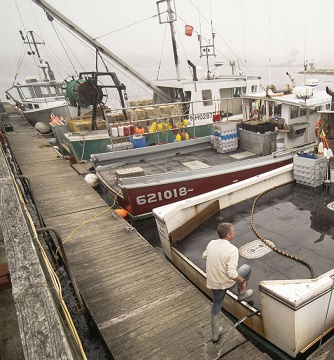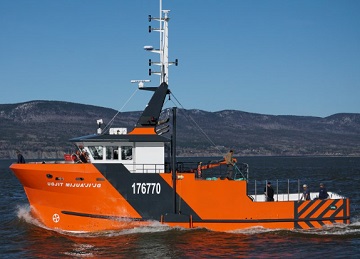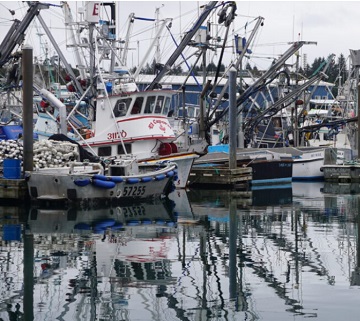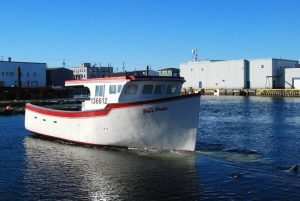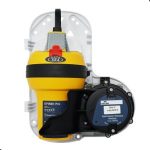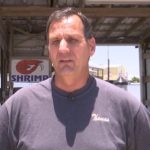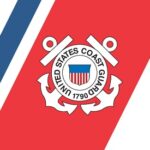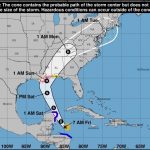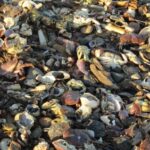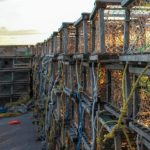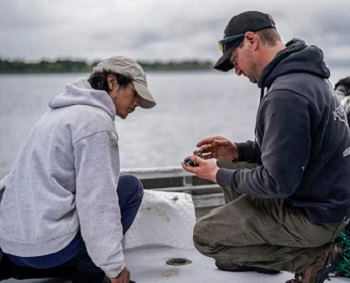 Lane Bolich first came to work in Alaska for the freedom and excitement that comes with being a fisher. A self-described adrenaline junkie, Bolich moved from his hometown in rural Washington state because he loves being on the ocean even in cold winter weather and it gave him the chance to make more money than back home. After working as a deckhand for two years on a family friend’s boat, Harmony, he took the wheel as captain this year at just 20 years old. Bolich is a rarity in an aging industry with high barriers to entry, equipment and access rights are costly, and increasing unpredictability as human-caused climate change alters marine habitats. As some fish populations dwindle and fewer people pursue the trade, fishers and conservation groups are actively working to bring in and retain the next generation of fishers through grants and training even as the industry continues to shrink in Alaska. 19 photos, >>click to read<< 09:38
Lane Bolich first came to work in Alaska for the freedom and excitement that comes with being a fisher. A self-described adrenaline junkie, Bolich moved from his hometown in rural Washington state because he loves being on the ocean even in cold winter weather and it gave him the chance to make more money than back home. After working as a deckhand for two years on a family friend’s boat, Harmony, he took the wheel as captain this year at just 20 years old. Bolich is a rarity in an aging industry with high barriers to entry, equipment and access rights are costly, and increasing unpredictability as human-caused climate change alters marine habitats. As some fish populations dwindle and fewer people pursue the trade, fishers and conservation groups are actively working to bring in and retain the next generation of fishers through grants and training even as the industry continues to shrink in Alaska. 19 photos, >>click to read<< 09:38
Tag Archives: commercial fishing
As climate change and high costs plague Alaska’s fisheries, fewer young people take up the trade
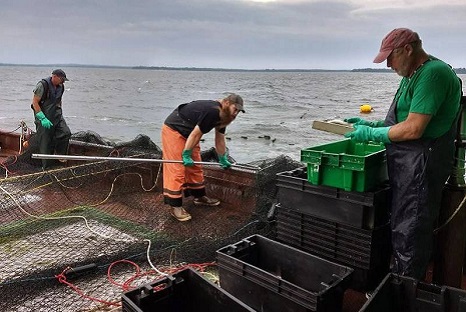
Commercial Fishing on the Great Lakes is a Family Affair
Although the number of fishermen who make a living on the waters of the Great Lakes is much diminished from a half century ago, the region’s commercial whitefish fishery continues to be viable and profitable. Henriksen Fisheries is one of about a dozen commercial entities in the Wisconsin waters of Lake Michigan, focused on trap netting whitefish in Green Bay and the waters surrounding the Door Peninsula. Charlie Henriksen started his family-owned fishing business in Door County in 1987. Originally from Illinois, the Henriksen family enjoyed vacations in Door County, and eventually bought a hotel on the peninsula and became year-round residents. Charlie was enticed into joining friends fishing on the water, and it eventually became his full-time vocation. In 1989 he purchased his first boat. Photos, >click to read< 18:55
EDITORIAL: Commercial fishing avoids being gaffed one more time
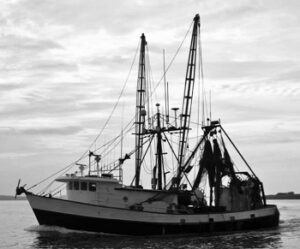 In August of 2020, almost three years before the date of the circuit court decision, a citizen’s lawsuit was filed against local shrimp trawl operators who regularly trawl for shrimp in Pamlico Sound. The plaintiffs argued that shrimp trawlers are violating the Clean Water Act by engaging in two type of unpermitted activity, “throwing bycatch (untargeted fish) overboard and disturbing sediment with their trawl net.” Named as defendants were local trawl owners who fortunately, with the help of outside support, were able to withstand the cost and time to defend themselves and by extension, the commercial fishing industry, during the three-year path of the lawsuit. >click to read< 08:15
In August of 2020, almost three years before the date of the circuit court decision, a citizen’s lawsuit was filed against local shrimp trawl operators who regularly trawl for shrimp in Pamlico Sound. The plaintiffs argued that shrimp trawlers are violating the Clean Water Act by engaging in two type of unpermitted activity, “throwing bycatch (untargeted fish) overboard and disturbing sediment with their trawl net.” Named as defendants were local trawl owners who fortunately, with the help of outside support, were able to withstand the cost and time to defend themselves and by extension, the commercial fishing industry, during the three-year path of the lawsuit. >click to read< 08:15
Abbott’s Harbour wharf blocked off without notice to fishermen
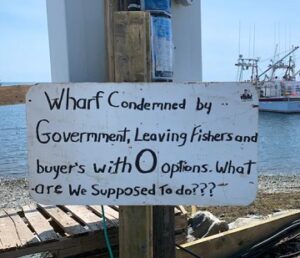 For Pubnico-area lobster fisherman Jaron d’Entremont, the Abbott’s Harbour wharf has been his home port since he began his fishing career six years ago. “One day I was there checking my boat and I saw inspectors there looking around checking underneath the wharf. A month later without any notice they put the blocks there and deemed it unsafe, “Fishermen are permitted to walk down on the Yarmouth County wharf to check their vessels, said d’Entremont, but vehicular traffic is prohibited. Diggdon noted the Abbott’s Harbour wharf is under DFO’s Small Craft Harbour program and is classified as a core fishing harbour meaning “it is deemed critical to the commercial fishing industry.” >click to read< 12:28
For Pubnico-area lobster fisherman Jaron d’Entremont, the Abbott’s Harbour wharf has been his home port since he began his fishing career six years ago. “One day I was there checking my boat and I saw inspectors there looking around checking underneath the wharf. A month later without any notice they put the blocks there and deemed it unsafe, “Fishermen are permitted to walk down on the Yarmouth County wharf to check their vessels, said d’Entremont, but vehicular traffic is prohibited. Diggdon noted the Abbott’s Harbour wharf is under DFO’s Small Craft Harbour program and is classified as a core fishing harbour meaning “it is deemed critical to the commercial fishing industry.” >click to read< 12:28
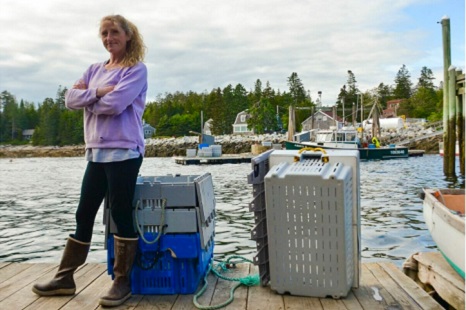
Meet the Women Making Waves in Maine’s Tough Lobster Industry
When Krista Tripp was 18, she’d completed all of the hours at sea necessary to get her captain’s license, but her parents submitted her brother’s paperwork to the State of Maine and not hers. Why? Even though Krista had been hauling traps since she was eight years old and running her own boat since 15, the expectation was that now she’d settle down and start having babies. “My brother and I shared the boat, we had 150 traps, and I became obsessed at an early age,” Tripp recalls. “I knew that was what I wanted to do. But, as a girl, my parents didn’t really take me seriously.” Tripp would spend the next few years working as a sternman off of a scallop boat in Massachusetts. Eventually, she returned to Maine, and after 14 years, she got herself off the waiting list and became the captain of her own lobster boat. Today, she has been captaining her own lobster boat for more than eight years. Photos, >click to read< 14:23
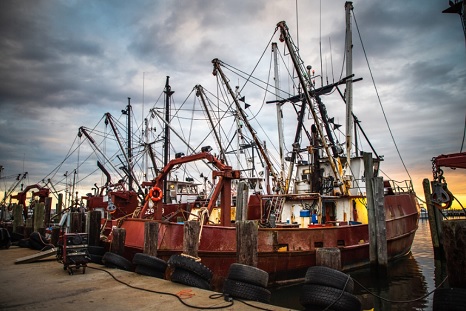
Viking Village Is A Uniquely Jersey Shore Experience
Viking Village seems like a place where time has stood still at the Jersey Shore and gives visitors a glimpse of what life was like during a time when fishing dominated the scene, long before tourism became the driving factor at the shore. The Viking Village, initially known as the Independent Fish Company, was founded as a lobster fishing co-op by first-generation Norwegian fishermen. As the lobster population began to decline, the fishermen adapted their gear and turned to sea bass fishing, which proved to be prosperous until the 1950s. Over the years, the fishing practices at the Viking Village evolved, incorporating scallop, gillnet, and longline fishing, which remain the backbone of its operations today. >click to read< 08:07

‘Deadliest Catch’ Star ‘Wild’ Bill Wichrowski Was Initially ‘Skeptical’ of the Show
The popular show reels viewers in with its unvarnished look at the rough-and-tumble world of commercial fishing. But not everyone who participates in the show was initially sold on the idea. Captain ‘Wild’ Bill Wichrowski has said that when he first heard about the series, he wasn’t eager to sign on. These days Wichrowski is a fixture on Deadliest Catch. But he actually wasn’t part of the show’s initial cast. He joined the series in season 6, which aired in 2010. The Great Recession had just happened, and the economic downturn prompted him to say yes to filming. Wichrowski, however, was a holdout. The idea of being on TV “just didn’t hold interest,” he said. Wichrowski said his reality TV fame helped him promote causes he was passionate about, such as the Wounded Warrior Project. photos, video >click to read< 14:51
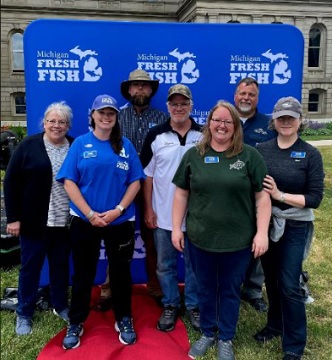
Bay Port Fish Company part of first Fresh Fish Expo in Lansing
Legislators and residents were gathered on the lawn of the capitol building in Lansing for the first Fresh Fish Expo, where the commercial fishing companies in Michigan provided education on the freshwater resource and were cooking up fish for those in attendance on June 13. The Bay Port Fish Company was present and brought over plenty of fish for the occasion. The company is one of eight commercial fishing license holders in the state. “A lot of people came that didn’t know about commercial fishing,” said Lakon Williams, co-owner of Bay Port Fish Company. “They were able to meet the people who provide the fish in the state and have conversations with them.” 9 photos, >click to read< 17:55
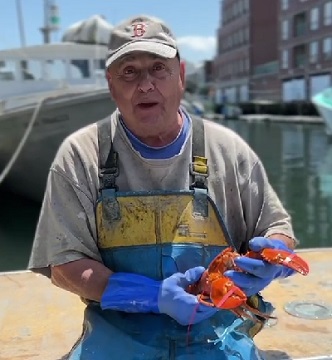
Lobsterman catches 3rd rare orange lobster in a week
A lobsterman working out of Portland caught his third rare orange lobster in a week on Thursday. Capt. Peter Pray showed up at Harbor Fish Market with another orange lobster, after catching two last Friday, according to CBS 13. Pray reportedly used the same trap he used to catch the first two. Pray caught the lobster using the same trap that he used to catch the first two. Photos, video, >click to read< 09:05
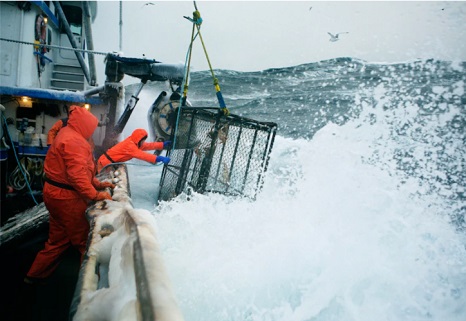
How Commercial Fisherman Corey Arnold Got Hooked On Fishing
Chris Arnold was an avocado grower and nurseryman, in Southern California, who bought a fishing boat when Corey was a toddler. He was reeling in baby sharks while still in diapers. “My dad was obviously busy with work and running a business, so fishing was a hobby for him,” says Arnold. “But I was 100 percent on fishing.” It was on a summer fishing trip to Alaska with his dad that Arnold first observed a commercial fishing operation — by 19, he had his first fishing job. He went on to work for seven years as a crab fisherman in Seattle, and eventually made his way to Alaska fishing for king crab on the F/V Rollo (featured on Season 2 of the Deadliest Catch) in the depths of winter, on the Bering Sea. Photos, >click to read< 11:15

Blue Float Energy’s offshore wind farm opposed by Port Macdonnell community due to fishing, tourism concerns
A small coastal community in regional South Australia is ramping up its opposition to a proposed offshore wind farm off the state’s south-east coast. Renewable energy company Blue Float Energy has lodged plans for a 77-turbine wind farm off the coast of Port Macdonnell which would generate 1.1 gigawatts of clean energy. The proposal has already met resistance from Port Macdonnell residents where the local economy relies on commercial fishing and seaside tourism. Local fishers say the 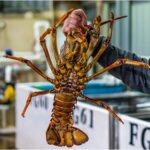 proposed area for the wind turbines, 8-20 kilometres offshore, is where many catch their lobster, with fears any exclusion zone placed around the turbines would make areas inaccessible. They are also concerned about any environmental impacts on lobster, despite no studies yet taking place. >click to read< 10:12
proposed area for the wind turbines, 8-20 kilometres offshore, is where many catch their lobster, with fears any exclusion zone placed around the turbines would make areas inaccessible. They are also concerned about any environmental impacts on lobster, despite no studies yet taking place. >click to read< 10:12
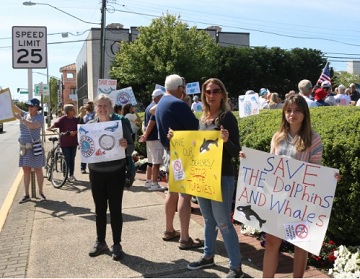
Wind Farm Protesters March in Ocean City
Opposition to the wind farm has been mounting following more than 30 whale deaths along the East Coast that critics have blamed on sonar mapping of the seabed that is needed for construction of the project. However, government agencies such as the National Oceanic and Atmospheric Administration and the New Jersey Department of Environmental Protection say the recent deaths of whales, dolphins and other marine creatures in New Jersey and other coastal states have nothing to do with the wind farm work. They say evidence shows that most of the whales were struck and killed by shipping traffic. Opponents reject those claims, though. During Saturday’s protest, speakers pointed the finger at the wind farm for the whale deaths and warned of other possible dire impacts that the project could have on the Jersey Shore’s environment, the tourism industry and commercial fishing operations. Photos, Video, >click to read< 07:55
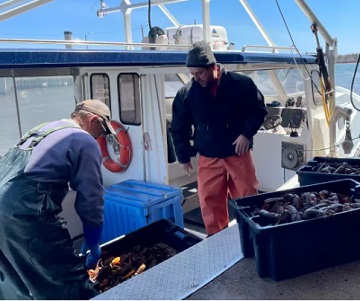
North Atlantic right whales causing ‘mess’ for P.E.I. lobster crews forced to move traps
Due to federal protocols, fishers had until Tuesday at 5 p.m. AT to move their gear out of waters deeper than 10 fathoms, about 18 metres, to protect the whales sighted late last week. The measure will last for 15 days, unless the whales are still in the area. Then the fishing area would be closed for at least another 15 days. “That’s not going to be good,” said Tony Clements, who fishes out of Northport. “We’re hoping for the best,” said David Henderson, who also moved 120 of his traps out of the closed zone. Out of 1,260 fishers, about 700 have already fully or partly converted to the whale-safe gear that will be mandatory by 2024. >click to read< 16:57

Shrimpers in Louisiana struggling to survive off low prices
Last week, shrimpers from across Louisiana held a rally at the State Capitol, blaming foreign imports for overcrowding the market. “You’re not breaking even right now, you’re in the red. Matter of fact, you’re below the red. I just don’t know what else to do,” Hackberry shrimper Kenny Kellum said. The abundance of foreign imported shrimp has caused prices to plummet in Louisiana, making it nearly impossible for shrimpers to survive. “We don’t want to give it up but we’re being forced out of something we’ve been doing all our lives and there’s no reason why somebody else should come in here and put us out of our living,” Kellum said. Video, >click to read< 16:34
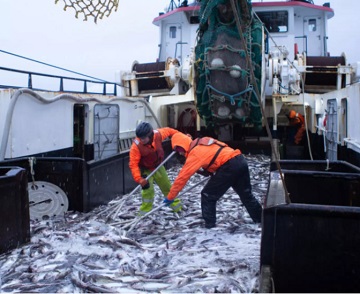
‘A’ season pollock quota back on par after decrease last season
Bering Sea pollock fishermen have almost met their “A” season quota. Since the fishery opened in late January, nearly 100 vessels have caught about 1.2 billion pounds of Alaska pollock. That leaves about 43 million pounds still available to catch. “It’s definitely a lot of fish,” said Krista Milani, a fisheries resources management specialist with the National Oceanic and Atmospheric Administration in Unalaska. “Sometimes when you think about the amount of pollock that they’re able to sustain in the Bering Sea, it’s kind of mind-blowing how much pollock is actually there.” According to NOAA, fishery managers were dealing with data gaps stemming from the COVID-19 pandemic. A population survey also came back lower than expected. “A” season ends June 10 — the same day “B” season starts. >click to read< 11:04
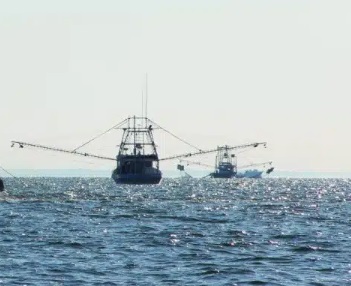
Shrimp season in Mississippi to open on May 22
The Mississippi Department of Marine Resources (MDMR) has set the opening date for the 2023-2024 shrimp season in state territorial waters for Monday, May 22 at 6 a.m. All regulations of the MDMR will be in full force and effect, and all boats engaged in catching and transporting shrimp from Mississippi waters must be licensed or permitted by the agency before beginning operations. Staff will continue to sample prior to the opening date. The shrimp season opening date may be postponed if sampling indicates movement of large numbers of juvenile brown shrimp into this area. >click to read< 13:04
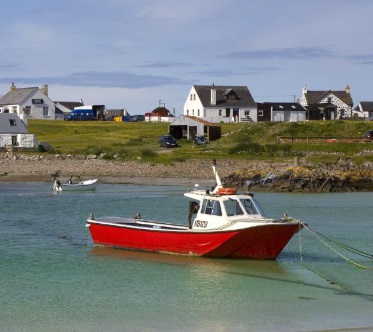
HPMAs: Tiree’s economy could sink unless plans are scrapped
In Tiree, there are good years and bad years. Years when crab and lobster are plentiful, years when they are not. Small boats work using fixed-line, static gear. Tiree fishermen place their creels with the precision afforded by sonar technology. There is no bycatch. Anything which will not be landed is thrown back alive. Many are voluntarily notching lobsters to ensure future stocks. Now, with the government’s proposals for statutory HPMAs, we are being told that our seas must be even more highly protected – from the people who live and work here. From us. >click to read< 10:01
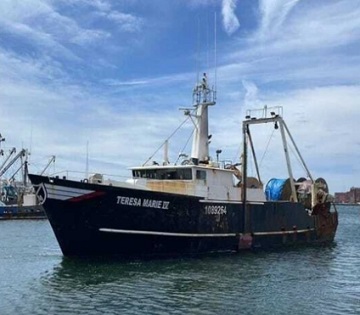
Environmental Regulations and Wind Turbines Are Backing New England Fishermen into a Corner
Just three weeks ago, Jerry Leeman was a commercial fishing captain in New England and a very successful one at that. Now, as executive director of the newly formed New England Fishermen Stewardship Association, he’s leading the charge against Biden administration policies that threaten the industry he loves, including overregulation and wind-turbine development in the Gulf of Maine. Leeman said that he and fellow New England fishermen have serious concerns about the accuracy of the NOAA data. Fish-population assessments fell to the wayside during the Covid years — 2021 and 2022 — and the data-collection process has not yet been corrected. “Whether you’re a lobsterman or a ground fisherman, a trend up and down the coast here is that nobody wants wind turbines placed in our environment. It’s going to mess up our stocks and our species. Not to mention it’s going to change the viability for generations to come in the fishing grounds,” Leeman said. Photos, >click to read< 07:51
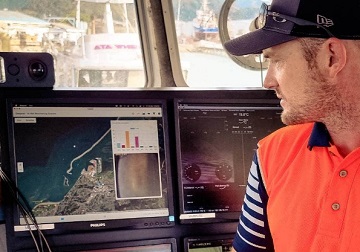
Fishing tech all set to net the catch of the day and nothing else
Dom Talijancich has every available sensor technology on board his 24-meter trawler, FV Mako. Everything but a camera and AI system that identifies what type of species are entering his net during a tow. If the technology were available, the Nelson fisherman and businessman would have got it immediately. But there was gap in the market for a piece of equipment like that, and it led him to developing his own company and the technology to do the job. Talijancich’s tech company Advanced Conservation Solutions (ACS) have tech that can improve the sustainability of commercial fishing using artificial intelligence (AI). >click to read< 08:53
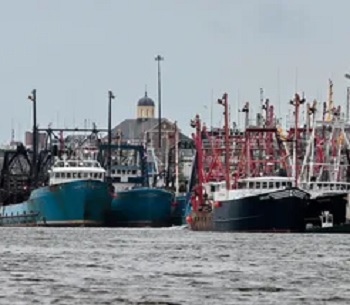
Profitable Port of New Bedford draws IRS scrutiny of tax evading fishermen
As the nation’s number one commercial fishing port, New Bedford is very much on the radar. “The statistics we have cover the six New England states but really the fishing industry is significant in Rhode Island, Maine and Massachusetts, with, of course, New Bedford being the most valuable port not only in New England but in the United States,” said IRS Criminal Investigation Supervisory Special Agent Matthew Amsden. Seven New England fishermen, including three from New Bedford and one from Fall River, were charged last month with tax evasion and failing to file returns. The other three indicted were from Rhode Island, according to a press release from the IRS Criminal Investigation unit. >click to read< 07:40
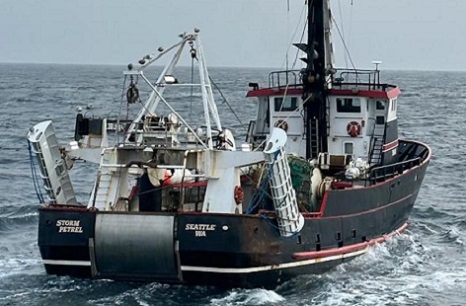
Tornados Make Bering Sea Debut
Seattle trawler Storm Petrel has finished its first trips using a pair of Tornado pelagic trawl doors from Vónin, and skipper Acácio DoMar has been impressed with how the new doors have handled. ‘They tow well, square well and shoot away well. They’re a great fit to what we do,’ he said, as the A-season for Alaska pollock was coming to an end. This is the 37-metre Storm Petrel’s main fishery. ‘We fish pollock for most of the year. There’s some codfish, but it’s a small season.’ The company did its homework ahead of investing in new doors, with Acácio DoMar’s fellow captain and fleet manager Dan Martin travelling to Scotland and other places to check out the latest technology. Photos, >click to read< 18:01

From Wheatley: Voyage to the bottom of the sea (Part 1)
I came to be speaking with Doug Johnston in the net repair room of Johnston Net and Twine, the shop, on County Road 3 on the east side of Wheatley, that Doug co-owns with his son, Rob. Doug has been in the Lake Erie commercial fishing industry for 67 of his 79 years. Of those, Doug was on Lake Erie for 34 years, and for about four years on Lake Huron, as a deckhand, and then captain and boat owner. To this day, he co-owns, with his son Rob, the Dorothy J – a 68-foot, 300-horsepower Lake Erie fish tug built in 1957 at Dunnville on the Grand River.Like most people who make their living in the commercial fishing industry, Doug has seen a lot of things: years when fish were plentiful, years when it seemed they had vanished; spectacular sunrises on smooth-as-glass water; and terrifying storms and fellow-fishermen lost and rescued. >click to read< 10:06

Democrats’ Green Agenda Will Gut America’s Oldest Industry And Turn Coastal Towns Into The New Appalachia
Biden’s regulators are driving fishermen of all kinds off the water in droves, while offshore wind development his administration backs is threatening access to productive fishing grounds. Coastal towns keyed to commercial fishing—like Stonington, Maine or Grand Isle, Louisiana—are facing social and economic oblivion. Fishermen are not a powerful political constituency. They do not give lavishly to politicians or command a powerful lobby in Washington. Of late, fishermen in the north Atlantic formed a grassroots organization, the New England Fishermen Stewardship Association (NEFSA), to advocate for jobs, coastal communities, and sustainable management of our oceans. >click to read< 13:35
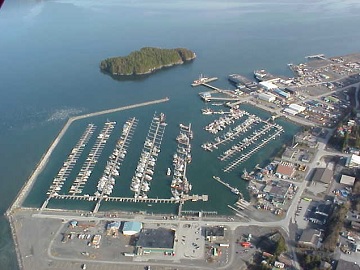
Big changes are coming to Cordova’s south harbor
Long overdue renovation of Cordova’s south harbor begins this fall, with a schedule that sets completion of the $40 million project in the spring of 2024. The project is under contract with Turnagain Marine Construction, an Anchorage firm that specializes in heavy civil marine construction, said Tony Schinella, who has served as harbormaster at Cordova for about a decade. “We are definitely excited,” said Schinella. “We’re well overdue for a facelift. The existing docks have been there about 40 years.” The revamp, initially expected to cost about $30 million,,, >click to read< 16:50
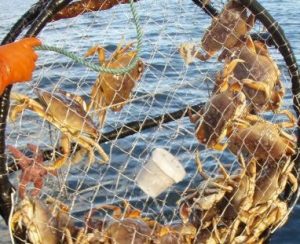
For Whales and Crabbers, Finding Balance Is Getting Harder
In Dick Ogg’s 25 years of commercial fishing, he’s had a few close encounters with whales—mostly while pulling Dungeness crab pots off the ocean floor. “I’ve had whales right next to me,” within about five meters, says Ogg. “They follow me, they watch, they’re curious. And then they go on about their business.” Ogg is fortunate his interactions have been so leisurely. For nearly a decade, California’s whales and crabbers have been locked in a persistent struggle. From 1985 to 2014, the National Oceanic and Atmospheric Administration (NOAA) reported an average of 10 whales were entangled in fishing gear each year along the west coast of the United States. >click to read< 07:53

Alaska officials prepare for possible commercial fishing expansion into Arctic waters
Bans on commercial fishing in U.S. and international Arctic waters have been lauded as admirable preemptive actions that protect vulnerable resources before they are damaged by exploitation. But now the Alaska Department of Fish and Game is preparing for a time when the 14-year-old moratorium on commercial fishing in federal Arctic waters is lifted. The department is seeking $1 million in state general funds and another $2 million in federal funds to work on research to better understand those Arctic waters in the event that commercial fisheries are conducted there, Fish and Game Commissioner Doug Vincent-Lang said on Wednesday. >click to read< 12:42






